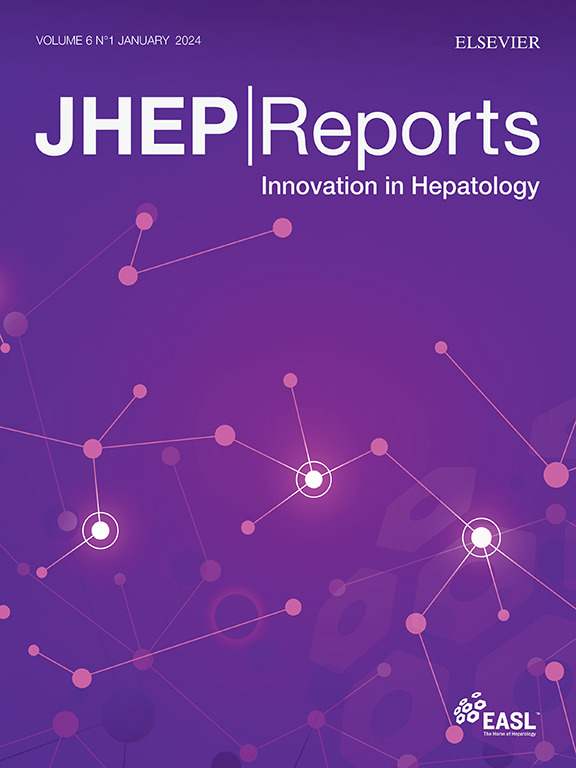西班牙HCC流行病学的演变
IF 9.5
1区 医学
Q1 GASTROENTEROLOGY & HEPATOLOGY
引用次数: 0
摘要
背景,目的:欧洲肝细胞癌(HCC)的流行病学状况正在发生变化。本研究旨在提供西班牙当前肝癌流行病学的最新描述。该多中心前瞻性研究收集了2022年10月至2023年1月期间原发性肝癌的人口学和临床数据。我们对2008年和2014年收集的数据进行了描述性和比较分析。结果在52个中心收集的767例原发性肝癌中,91%诊断为HCC。患者以男性居多(83.3%),平均年龄68岁,80.7%有肝硬化。主要原因是酒精(单独29.9%,55%合并其他病因)、与代谢综合征相关的肝脏疾病(LDrMS, 23%)和丙型肝炎(17.3%)。治疗包括消融(15.7%)、全身治疗(14.7%)和化疗栓塞(14.6%)。来自三个注册中心的29个中心(n = 1351)的数据显示,非肝硬化肝脏的LDrMS(从4.9%增加到24%)和HCC(从4.2%增加到7.9%)显著增加。与此同时,丙型肝炎急剧下降(从43%降至17.5%)。与酒精有关的病例保持稳定。男性患者、高血压、糖尿病和肥胖症的发病率略有上升。在筛查计划之外诊断为肝硬化的患者表现为更大的肿瘤和更晚期的疾病。这导致对治愈性治疗的评估较少。结论酒精占肝癌病例的30%,是HCC的主要病因。登记显示丙型肝炎相关HCC减少,LDrMS和非肝硬化肝HCC增加。在80%的推荐人群中实施了监测。有必要改进筛查和预防策略,特别是酒精滥用和LDrMS,以加强HCC管理。影响和启示我们的研究展示了西班牙众多参考中心的参与,并检查了1300多名患者,以跟踪14年来肝细胞癌(HCC)流行病学的变化。在已知肝硬化的患者中,超过80%的HCC诊断是通过筛查进行的,从而导致早期发现和治愈治疗的机会。值得注意的是,登记的HCC病因已从丙型肝炎转变为与代谢综合征相关的肝病,无肝硬化的病例有所增加。研究结果表明,需要预防和早期发现HCC,特别是关注与代谢综合征相关的酒精和肝脏疾病,以及卫生当局的更多参与,以提高高危患者在筛查计划中的参与度。本文章由计算机程序翻译,如有差异,请以英文原文为准。

Evolving epidemiology of HCC in Spain
Background & Aims
The epidemiological landscape of hepatocellular carcinoma (HCC) in Europe is evolving. This study aims to provide an updated description of the current epidemiology of liver cancer in Spain.
Methods
This multicenter prospective study collected demographic and clinical data on primary liver cancer between October 2022 and January 2023. We conducted descriptive and comparative analyses with data collected in 2008 and 2014.
Results
Of the 767 cases of primary liver cancer collected from 52 centers, 91% were diagnosed as HCC. The majority of patients were male (83.3%), average age 68 years, 80.7% had cirrhosis. The primary causes were alcohol (29.9% alone, 55% combined with other etiologies), liver disease related to metabolic syndrome (LDrMS, 23%) and hepatitis C (17.3%). Treatments included ablation (15.7%), systemic therapy (14.7%), and chemoembolization (14.6%). Data from 29 centers (n = 1,351) across three registries revealed a significant increase in LDrMS (from 4.9% to 24%) and HCC in non-cirrhotic livers (from 4.2% to 7.9%). Meanwhile, hepatitis C decreased sharply (from 43% to 17.5%). Alcohol-related cases remained stable. There was a slight increase in male patients and hypertension, diabetes, and obesity. Patients with cirrhosis diagnosed outside of screening programs presented with larger tumors and more advanced disease. This led to fewer evaluations for curative treatments.
Conclusions
Alcohol accounts for 30% of HCC cases and is the main etiology. The registry shows a decrease in hepatitis C-related HCC, an increase in LDrMS and HCC in non-cirrhotic livers. Surveillance was implemented in ∼80% of the recommended population. There is a need for improved screening and prevention strategies, particularly for alcohol abuse and LDrMS, to enhance HCC management.
Impact and implications
Our study showcases the involvement of numerous reference centers across Spain and examines over 1,300 patients to track the changing epidemiology of hepatocellular carcinoma (HCC) over 14 years. In patients with known liver cirrhosis, more than 80% of HCC diagnoses were made through screening leading to early-stage identification and curative treatment opportunities. Notably, there has been a shift in HCC etiology within the registries from hepatitis C to liver disease related to metabolic syndrome, with an increase in cases without cirrhosis. Findings indicate a need for the prevention and early detection of HCC, particularly focusing on alcohol and liver disease related to metabolic syndrome, along with greater involvement of health authorities, to improve the participation of at-risk patients in screening programs.
求助全文
通过发布文献求助,成功后即可免费获取论文全文。
去求助
来源期刊

JHEP Reports
GASTROENTEROLOGY & HEPATOLOGY-
CiteScore
12.40
自引率
2.40%
发文量
161
审稿时长
36 days
期刊介绍:
JHEP Reports is an open access journal that is affiliated with the European Association for the Study of the Liver (EASL). It serves as a companion journal to the highly respected Journal of Hepatology.
The primary objective of JHEP Reports is to publish original papers and reviews that contribute to the advancement of knowledge in the field of liver diseases. The journal covers a wide range of topics, including basic, translational, and clinical research. It also focuses on global issues in hepatology, with particular emphasis on areas such as clinical trials, novel diagnostics, precision medicine and therapeutics, cancer research, cellular and molecular studies, artificial intelligence, microbiome research, epidemiology, and cutting-edge technologies.
In summary, JHEP Reports is dedicated to promoting scientific discoveries and innovations in liver diseases through the publication of high-quality research papers and reviews covering various aspects of hepatology.
 求助内容:
求助内容: 应助结果提醒方式:
应助结果提醒方式:


